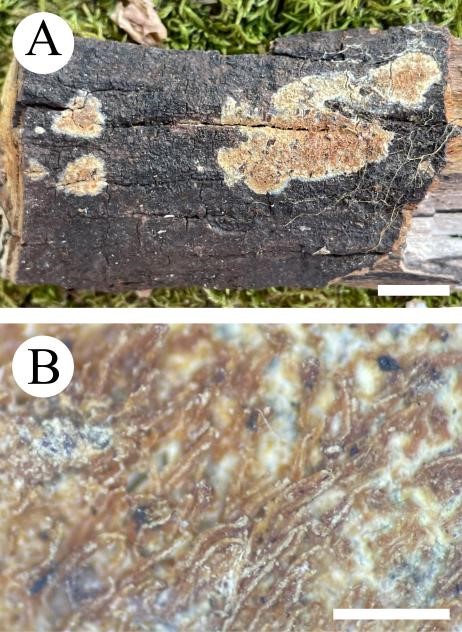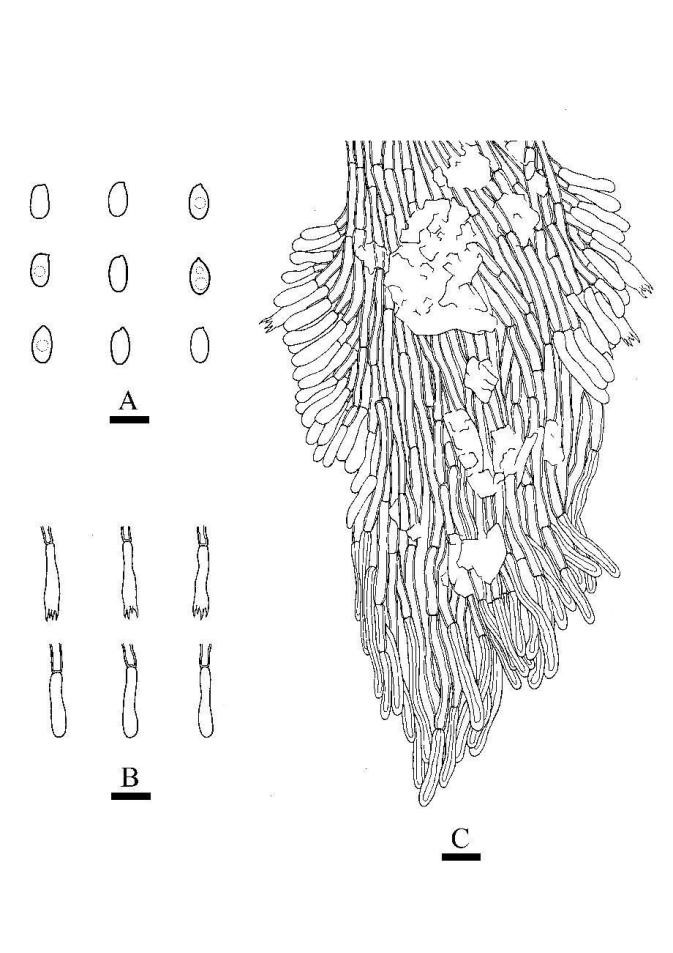Mycoaciella brunneospina Authority
MycoBank number: MB 843324; Index Fungorum number: IF 843324; Facesoffungi number: FoF 12690;
Description
Basidiomata annual, resupinate, ceraceous, without odor or taste when fresh, becoming coriaceous upon drying, up to 8 cm long, 2.5 cm wide, 0.8–1.5 mm thick. Hymenophore hydnoid, cylindrical spines 4–5/mm, buff to slightly brown when fresh, slightly brown to brown upon drying. Sterile margin narrow, buff, fimbriate. Hyphal structure monomitic; generative hyphae with simple septa, unbranched, 3–5 μm in diameter, colorless, thick-walled, IKI–, CB–; tissues unchanged in KOH. Hymenium cystidia and cystidioles absent; the presence of larger, yellow to yellowish brown gelatinous substance; basidia clavate, with four sterigmata and a basal simple septum, 11.5–19.5 × 4–5 μm. Basidiospores ellipsoid, colorless, thin-walled, smooth, often with 1-2 oil drops, IKI–, CB–, (3.7–)3.9–4.8 × (1.8–)2–2.7 μm, L = 4.17 µm, W = 2.36 µm, Q = 1.77 (n = 30/1).
Material examined: China, Yunnan Province, Wenshan, Xichou County, Jiguanshan Forestry Park, E 104°39′, N 23°10′, alt. 1800 m, on the angiosperm trunk, 22 Jul 2019, C.L. Zhao, CLZhao 15876 (SWFC).
Distribution: The species is known from Yunnan Province, China, in a subtropical evergreen broad-leaved forest. It grows on moderately decayed angiosperm wood and causes white rot.
Sequence data: ITS: MW732404 (ITS5/ITS4); LSU: MW724796 (LROR/LR7); RPB1: ON892515 (RPB1-Af/RPB1-Cr); mtSSU: MW732764 (MS1/MS2)
Notes: Mycoaciella brunneospina groups with M. bispora (Stalpers) J. Erikss. & Ryvarden in phylogenetic tree (Fig. 2), but M. bispora differs in its dimitic hyphal system and larger basidiospores (5–6.5 × 2.5–3 μm; Stalpers 1976).

Fig. 1 Basidioma of Mycoaciella brunneospina (holotype). — Scale bars: A = 1 cm, B = 1 mm.

Fig. 2 Microscopic structures of Mycoaciella brunneospina (drawn from the holotype). A. Basidiospores; B. Basidia and basidioles; C. A section of hymenium. — Scale bars: A = 5 μm, B–C = 10 μm.
